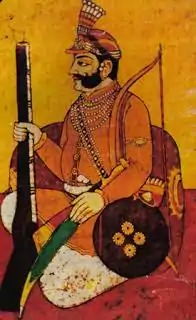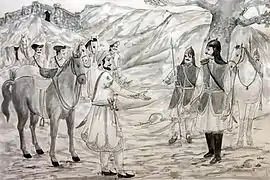Chhatrasal
Maharaja Chhatrasal (4 May 1649 – 20 December 1731) was a medieval Indian warrior from the Bundela Rajput clan who fought against the Mughal Empire, and established his own kingdom in Bundelkhand.[1]
| Chhatrasal | |
|---|---|
| Maharaja of Bundelkhand | |
 | |
| Ruler of Bundelkhand | |
| Reign | 1675–1731 |
| Predecessor | Post established |
| Successor | Harde Sah (Panna State) Jagat Rai (Jaitpur State) Bharti Chand (Jaso State) |
| Born | 4 May 1649 Kachar Kachnai, Mughal Empire (Present day: Kachar Kachnai, Tikamgarh District, Madhya Pradesh, India) |
| Died | 20 December 1731 (aged 82) |
| Spouse | Dev Kunwari, Ruhaani Bai (protected) |
| Issue | Harde Sah Jagat Rai Bharti Chand Mastani |
| House | Bundela |
| Father | Champat Rai |
| Mother | Lal Kunwar |
| Religion | Hinduism |
Early life
Chhatrasal was born in Kachar Kachnai on 4 May 1649, to Champat Rai and Lal Kunwar into the Bundela Rajput clan. He was a descendant of Rudra Pratap Singh of Orchha.[2] His ancestors were vassals of the Mughal emperor.
Power Struggle against the Mughals

Chhatrasal was 12 when his father Champat Rai of Mahoba was killed by the Mughals. Inspired by Chhatrapati Shivaji's ideals he travelled to Maharashtra and sought guidance from him. Chhatrasal raised the banner of revolt against the Mughals in Bundelkhand at the age of 22, with an army of 5 horsemen and 25 swordsmen, in 1671.[3] During the first ten years of his revolt he conquered a large tract of land between Chitrakoot, Chhatarpur and Panna on the east and Gwalior on the west. His domains stretched from Kalpi in the north to Sagar, Garhakota, Shahgarh and Damoh in the south. Some of the Mughal generals who were defeated by him were Rohilla Khan, Kaliq, Munawwar Khan, Sadruddin, Sheikh Anwar, Sayyid Latif, Bahlol Khan and Abdus Ahmed.
Chhatrasal was able to defeat the Mughals until he was attacked by Muhammad Khan Bangash on December 1728. Chhatrasal was 79 years old when he led his army against Bangash, after a severe battle Chhatrasal was defeated and was forced to retreat to his fort at Jaitpur. The Mughals besieged him and conquered most of his territories. Chhatrasal made several attempts to ask the Peshwa for help however the Peshwa was busy and could not help Chhatrasal until March 1729. In a letter sent to Bajirao, Chhatrasal wrote: "Know you Bajirao! That I am in the same plight in which the famous elephant was when caught by the crocodile. My valiant race is on the point of extinction. Come and save my honour".[4] Peshwa Bajirao I personally led his army towards Bundelkhand and attacked several Mughal outposts, the Mughal supplies were completely cut off by the swift Cavalry of the Peshwa. Bangash who was surprised by the sudden involvement of the Marathas, sent several letters to the Mughal emperor for aid, however upon being denied any help he started negotiations with Chhatrasal and Bajirao. Bangash was allowed to retreat on the condition that he never returns or shows aggression towards Bundelkhand. Chhatrasal rewarded the peshwa with large tracts of lands and diamond mines in Bundelkhand which helped the Marathas to gain access in Central and North India.[5][6]
Relations with Bajirao I

The Maratha Peshwa Baji Rao I's second wife Mastani was Chhatrasal's daughter born from his Muslim concubine.[7] [2] In his book Mastani, the historian D. G. Godse states that the relationship between Chhatrasal and Baji Rao I was like that of father and son.
Before his death on 20 December 1731, Chhatrasal bequeathed Mahoba and the surrounding area to Baji Rao I in return for Baji Rao's assistance against the Mughals.
Patron of literature
Chhatrasal was a patron of literature, and his court housed several noted poets. His eulogies written by Kavi Bhushan, Lal Kavi, Bakhshi Hansaraj and other court poets helped him gain lasting fame.[8]
Religious views
Chhatrasal was a disciple of Mahamati Prannathji and accepted him as his guru. Their meeting took place in Mau Sahaniya in 1683, a place near Panna. His nephew Dev Karanji who had met Swami Prannathji, earlier in Ramnagar, was instrumental for this meeting. Chhatrasal was highly impressed of Prannathji and became his disciple. When Maharaja Chhatrasal came to meet him, he was going for a battle against Mughals. Swami Prannathji gave him his own sword and covered his head with a scarf, saying, "You will always be victorious. Diamond mines will be discovered in your land and you will become a great emperor." His prophecy came true and even today Panna region is famous for their diamond mines. Swami Prannathji was not only the religious Guru of Chhatrasal; but he guided him too in political, social, and economic matters. It was by being granted the boon of finding diamonds in Panna by Swami Prannathji that Maharaja Chhatrasal became prosperous.[9][10][11]
Successors and descendants
Chhatrasal gave a third of his kingdom to Marathas under Peshwa Baji Rao I for his assistance, the other parts of his kingdom was divided amongst his sons. The eldest son, Harde Sah was given the kingdom of Panna State; second son, Jagat Rai was given Jaitpur State and the youngest son Bharti Chand was given Jaso State.[12] The Jaitpur State was further divided into Ajaigarh State, Bijawar State, Charkhari State and Chhatarpur State by his descendants.
Legacy
The Chhatarpur town and its eponymous district in Madhya Pradesh are named after Chhatrasal. Several places in Chhatarpur, including the Maharaja Chhatrasal Museum, are named after him. The Chhatrasal Stadium in Delhi is also named after the Maharaja Chhatrasal.
Rulers of Panna
- Chhatrasal 1707 - 1731. His sons divided Panna, Jaitpur, Ajaigarh, Bijawar, Charkhari, Chhatarpur and Jaso.[13][14]
- Harde Sah / Hirde Sah (eldest son of Chhatrasal) 1731 - 1739
- Sabha Singh 1739 - 1752
- Aman Singh 1752 - 1758
- Hindupat Singh 1758 - 1778
- Anirudh Singh 1778 - 1779
- Dhokal Singh 1785 - 1798
- Kishor Singh 1798 - 1834
- Harbans Rai 1834 - 1849
- Mahendra Nirpat Singh 1849 - 1870
- Sir Rudrapratap Singh 1870 - 1893
- Lokpal Singh 1893 - 1898
- Madho Singh 1898 - 1900
- H.H. Maharaja Yadavendra Singh 1901 - 1963 (Uparajya Pramukh of Vindhya Pradesh (1947–1950)) At the same time he was guided by his two brothers who ruled together and were allotted separate Jagirs.
- (Majhle) Maharaja Raghavendra Singh Ju Deo 1901-1963, Finance Treasury
- (Nanhe )Maharaja Raja Lt. Colonel. Bhartendra Singh Ju Deo, MSc.Home And Police Governance 1901-1963.
Further reading
- Bhagavānadāsa Gupta, Life and times of Maharaja Chhatrasal Bundela, New Delhi, Radiant (1980). ISBN 1-135-47177-0
- Bhagavānadāsa Gupta, Contemporary Sources of the Mediaeval and Modern History of Bundelkhand (1531-1857), vol. 1 (1999). ISBN 81-85396-23-X.
- "Mastani" by D. G. Godse
- Dharmika Teja, a Kannada language historical novel; the story revolves around Maharaja Chhatrasal's youth
References
- Sen, Sailendra (2013). A Textbook of Medieval Indian History. Primus Books. pp. 187–188. ISBN 978-9-38060-734-4.
- Bundela Rajas of Bundelkhand (Panna)
- Advanced Study in the History of Modern India 1707-1813 pg.106
- Srinivasan, Bajirao I, pg77
- Advanced Study in the History of Modern India 1707-1813 pg.106
- Advance Study in the History of Modern India (Volume-1: 1707-1803) By G.S.Chhabra pg.24
- Jaswant Lal Mehta (1 January 2005). Advanced Study in the History of Modern India 1707-1813. Sterling Publishers Pvt. Ltd. p. 108. ISBN 978-1-932705-54-6.
Of his own sweet will The Rajput king bestowed a large number of Personal Jagir to Bajirao near Jhansi and further offer hand of her daughter Mastani born from his Muslim Concubine
- K. K. Kusuman (1990). A Panorama of Indian Culture: Professor A. Sreedhara Menon Felicitation Volume. Mittal Publications. p. 157. ISBN 978-81-7099-214-1. Retrieved 10 December 2012.
- Pranami Faith : Saints of Pranami Dharma : Texts
- The Pranami Faith: Beyond `Hindu’ and `Muslim’- Dominique-Sila Khan
- Identity and religion: foundations of anti-Islamism in India By Amalendu Misra
- Jain 2002, p. 3.
- Bundela Rajas of Bundelkhand (Panna)
- Statistical, descriptive and historical account of the North-western Provinces of India, ed. by E.T. Atkinson [and others, North-western provinces Editor Edwin Felix T. Atkinson, 1874]
External links
 Media related to Chhatrasal at Wikimedia Commons
Media related to Chhatrasal at Wikimedia Commons